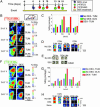Visualization of a primary anti-tumor immune response by positron emission tomography
- PMID: 16293690
- PMCID: PMC1283986
- DOI: 10.1073/pnas.0508698102
Visualization of a primary anti-tumor immune response by positron emission tomography
Abstract
Current methodologies that monitor immune responses rely on invasive techniques that sample tissues at a given point in time. New technologies are needed to elucidate the temporal patterns of immune responses and the spatial distribution of immune cells on a whole-body scale. We describe a noninvasive, quantitative, and tomographic approach to visualize a primary anti-tumor immune response by using positron emission tomography (PET). Bone marrow chimeric mice were generated by engraftment of hematopoietic stem and progenitor cells transduced with a trifusion reporter gene encoding synthetic Renilla luciferase (hRluc), EGFP, and Herpes virus thymidine kinase (sr39TK). Mice were challenged with the Moloney murine sarcoma and leukemia virus complex (M-MSV/M-MuLV), and the induced immune response was monitored by using PET. Hematopoietic cells were visualized by using 9-[4-[(18)F]fluoro-3-(hydroxymethyl)butyl]guanine ([(18)F]FHBG), a radioactive substrate specific for the sr39TK PET reporter protein. Immune cell localization and expansion were seen at the tumor and draining lymph nodes (DLNs). 2-[(18)F]fluoro-2-deoxy-D-glucose ([(18)F]FDG), which is sequestered in metabolically active cells, was used to follow tumor growth and regression. Elevated glucose metabolism was also seen in activated lymphocytes in the DLNs by using the [(18)F]FDG probe. When M-MSV/M-MuLV-challenged mice were treated with the immunosuppressive drug dexamethasone, activation and expansion of immune cell populations in the DLNs could no longer be detected with PET imaging. The method we describe can be used to kinetically measure the induction and therapeutic modulations of cell-mediated immune responses.
Figures




References
-
- Butcher, E. C., Williams, M., Youngman, K., Rott, L. & Briskin, M. (1999) Adv. Immunol. 72, 209-253. - PubMed
-
- Therasse, P., Arbuck, S. G., Eisenhauer, E. A., Wanders, J., Kaplan, R. S., Rubinstein, L., Verweij, J., Van Glabbeke, M., van Oosterom, A. T., Christian, M. C. & Gwyther, S. G. (2000) J. Natl. Cancer Inst. 92, 205-216. - PubMed
-
- Iparraguirre, A. & Weninger, W. (2003) Int. Arch. Allergy Immunol. 132, 277-293. - PubMed
-
- Shah, K., Jacobs, A., Breakefield, X. O. & Weissleder, R. (2004) Gene Ther. 11, 1175-1187. - PubMed
-
- Gambhir, S. S. (2002) Nat. Rev. Cancer 2, 683-693. - PubMed
Publication types
MeSH terms
Substances
Grants and funding
LinkOut - more resources
Full Text Sources
Other Literature Sources

